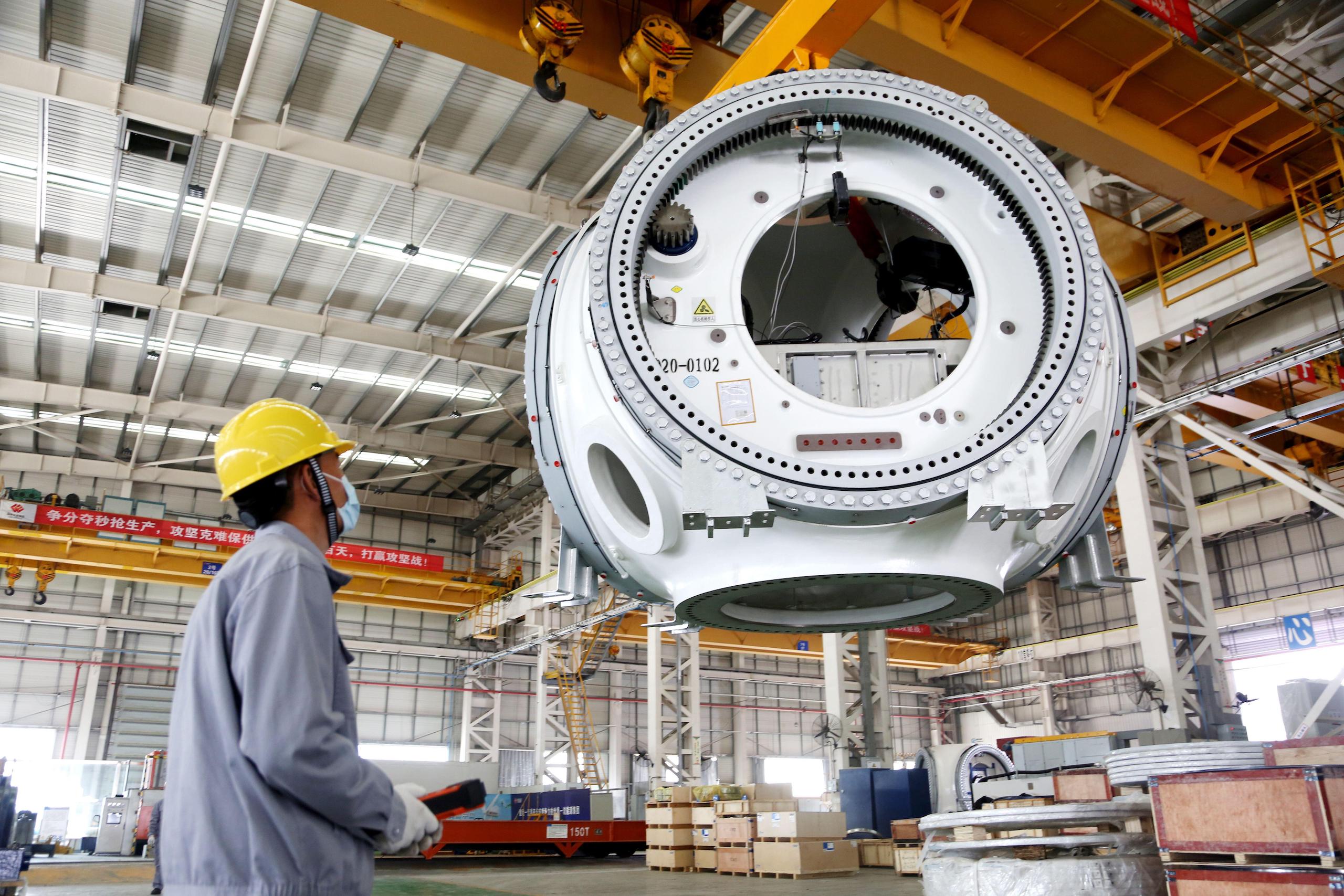In 2020, China accounted for 28% of the world’s carbon emissions, and those emissions are still rising. Nevertheless, it has announced its commitment to reaching net-zero carbon emissions before 2060. Given its enormous coal-dependent infrastructure, large heavy-manufacturing base, and rapid rate of urbanisation, transitioning away from fossil fuels will be very challenging.
There is every sign that China is embracing this challenge in a serious manner. It is the top global producer and user of renewable energy, and top producer of electric vehicles (EVs). It has instituted a carbon trading scheme that covers power generation, a sector which accounts for 40% of the country’s emissions. And it has dramatically improved energy efficiency across multiple sectors. In October 2021, the State Council issued a roadmap for decarbonisation with five guiding principles, dozens of measures, and emission targets for 2025, 2030 and 2060. Yet, just weeks later at COP26, China disappointed some governments by not setting more ambitious near-term emission reduction targets.
This raises several questions: How should a country measure success in meeting the challenges of climate change? Are short-term policies to lower emissions as quickly and as much as possible necessarily the most effective approach right now? What about investments in new technologies, like advanced nuclear energy or green hydrogen, that may play only a small role in the near term, but in the long run may prove to be very important in achieving deeper carbon reduction goals?
The climate problem is one of global cumulative emissions. The climate is relatively insensitive to emissions pathway in the immediate term. Speedy reductions in emissions are less important than China establishing a solid foundation for deep reductions in the long run, ultimately reaching net zero as fast as possible.
We believe one should take a broad view of national efforts to reach net-zero emissions. Near-term emission reductions are undeniably important. But at the same time, there are critical steps China can take now that may not result in significant emission reductions by 2030, but will be essential for “deep decarbonisation”: the sustained and far-reaching efforts that dercarbonise an economy to levels in the 75-90% range. For example, China’s ten-year effort to grow the EV sector has so far had a relatively minor effect on reducing its near-term emissions, due to the carbon intensity of its coal-dominated electricity sector. But in the long run, if China can decarbonise its electricity mix, the electrification of vehicles will accelerate deeper decarbonisation.
In our recent book, Foundations for a Low-Carbon Energy System in China, we, along with five other scholars, argue that China should use the present decade to address three priority areas. First, it should invest in the infrastructure and institutional reforms that will allow faster deployment of clean technologies in the following two decades. Second, China should look to develop the next generation of critical technologies to achieve deeper reductions. And finally, the nation should continue to pursue short-term mitigation targets, but only where the technologies are commercially available and the institutions are in place.
Here, we focus on the first of these three recommendations: institutional reforms. Compared to measurements such as electric cars sold or solar facilities constructed, which are tangible and easy to monitor, institutional reforms are harder to achieve. Their success cannot be easily measured, and they can be disruptive to incumbent stakeholders. However, they are essential if countries are to achieve their decarbonisation goals. Institutional reforms in three areas are especially important for China.
1. Addressing intermittency
To meet its 2060 target, China will have to electrify much of its industrial and transportation sectors, and simultaneously transition its electricity system from a baseload, coal-reliant system to one structured around non-fossil fuels – a significant proportion of which will be intermittent, such as wind and solar.
Apart from biofuels, and perhaps green hydrogen for a few uses, all the energy technologies to reach net zero are based on electricity. But the electricity system that played an instrumental role in powering China’s economic growth is not the same system needed to meet its decarbonisation goals. Demand response, smart grids, distributed energy systems and heat pumps, for example, have not played a major role in China’s energy strategy. Planners and investors have been more accustomed to focusing on big infrastructure projects as opposed to small-scale demand strategies. The energy systems of the future will require more of a balance between the two.
In the last 20 years, China’s baseload-generating plants reached efficiency levels not duplicated anywhere else in the world. Now, it must reform the operations of its transmission and grid systems to achieve equally impressive levels of efficiency. Specifically, it will need to develop alternative dispatch protocols that focus more on the overall efficiency of its grid, as opposed to guaranteeing revenue to less efficient generating facilities.
Combining storage technologies with renewable energy may allow China to retire its thermal facilities without much cost
The electricity system of the future, with its high levels of wind and solar power, will be more intermittent, but will have the capability to manage demand as well as supply. China’s present system of tariffs is based on average costs, which are set in a non-transparent process. Hence investors – including state-owned companies – are left guessing to predict the value of their investments. This system worked when plants were centred on supplying baseload and their availability was easy to forecast. Neither will be the case in the future. China must incentivise investors in new storage technologies, as well as owners of large, efficient coal facilities to cycle up and down as the availability of wind and solar generation fluctuates. Interestingly, combining storage technologies with measurable volumes of renewable energy may allow China to retire many of its older, less efficient thermal facilities without much of a cost penalty.
Ironically, China’s success in improving the efficiency of its power production has had the unintended consequence of making its electricity grid less flexible, but the future deployment of thousands of solar and wind facilities will require more flexibility. China will also need to stimulate investment in advanced technologies that simultaneously balance consumption and production. Finally, it will need tariffs that encourage the development of thousands of charging units to power the EVs that may soon dominate the passenger transportation sector.
2. Making use of markets
Historically, China has been resistant to marketisation of its energy sector for various political, financial and security reasons. But to meet its goal of decarbonisation before 2060, the greater use of market-based initiatives in the electric power and renewable energy sectors could achieve lower costs, greater efficiencies and accelerated deployment of cleaner technologies.
Large state-owned companies have played an important role in building and operating China’s electricity system. The role of centralised government planning, standards, regulations and subsidies have made impressive contributions to the country’s success. National energy infrastructure projects, such as long-distance transmission lines, typically involve high costs that take years to recover, and are ideally planned before generator construction. It is difficult for individual market players to take on all the risks inherent in such projects, so strong state intervention and financial supports are needed.
By contrast, decarbonisation will require millions of investment decisions, made by thousands of officials at all levels of government over several decades. An even greater number of people will be making decisions about what kind of vehicle to drive, what kind of heating and cooling systems to install, and which appliances to purchase. All these decisions will affect China’s future carbon emissions. To achieve greater certainty about the future costs and benefits of these decisions, consumers and suppliers will need an idea of the future cost of carbon. This realisation is what has driven China to implement the largest carbon trading system in the world. This impressive step must be followed by extending the trading system to other sectors beyond power generation, and by instituting a hard cap on emissions.
3. Building a safety net for fossil fuel workers
There are millions of people employed in the fossil fuel industry or in related carbon-intensive sectors, such as electricity generation, steel and cement. Many of them will be displaced as the transition to a net-zero economy gains momentum. A percentage are retired workers, who receive pensions from the companies for whom they worked. Others will need to be retrained and perhaps relocated. To further complicate matters, these workers are disproportionately located in just four or five provinces.
Transition planning cannot overlook these people. This issue has become particularly sensitive in recent years, as China has already lost over 1.2 million jobs in the coal industry. A viable social safety net is as important to a net-zero future as any renewable energy incentive or energy-efficiency policy. This task will be challenging, particularly for the provincial governments that are most affected and who will need greater technical and financial assistance from Beijing.
A viable social safety net is as important to a net-zero future as any renewable energy incentive
In transforming itself from a rural agrarian society to an industrial powerhouse in half a century – lifting millions of people out of poverty in the process – China achieved an unprecedented historical feat. It did so by marshalling the capacity of the public sector to undertake large capital-intensive projects: the construction of large power plants, high-speed rail, new port facilities and world-class oil refineries. But in the transition to net zero emissions, the same approach will not suffice. As we have highlighted, China will need to deploy systems that are much more flexible and decentralised, and rely more on incentives than directives.
In a sense, China faces the exact opposite challenge faced by the United States – the second largest carbon emitter. The US has large supplies of natural gas which can serve as a bridge fuel, and decades of experience using decentralised market mechanisms, but it lacks a strong centralised system of governance that can tackle problems of national importance. China, on the other hand, has repeatedly shown that it can aggregate resources to accomplish major changes. But its inexperience with and distrust of decentralised systems continue to hamper its decarbonisation efforts. Implementing the institutional reforms necessary to overcome these gaps will no doubt be challenging, but the stakes for China are high – and will grow even higher as time passes.
Foundations for a Low-Carbon Energy System in China by Henry Lee, Daniel Schrag et al was published in December 2021 by Cambridge University Press.








